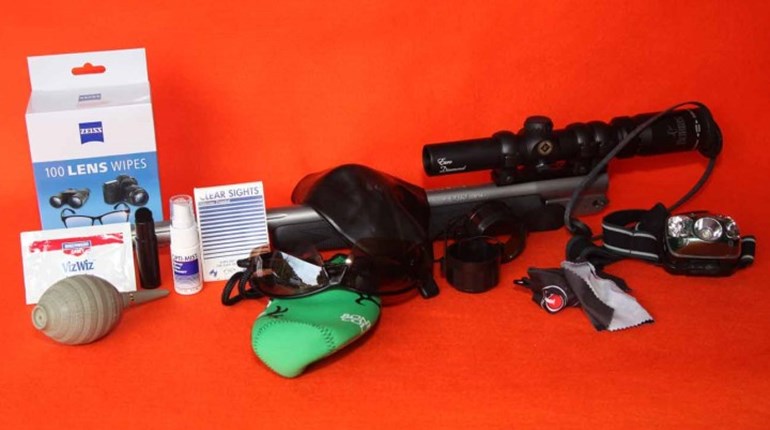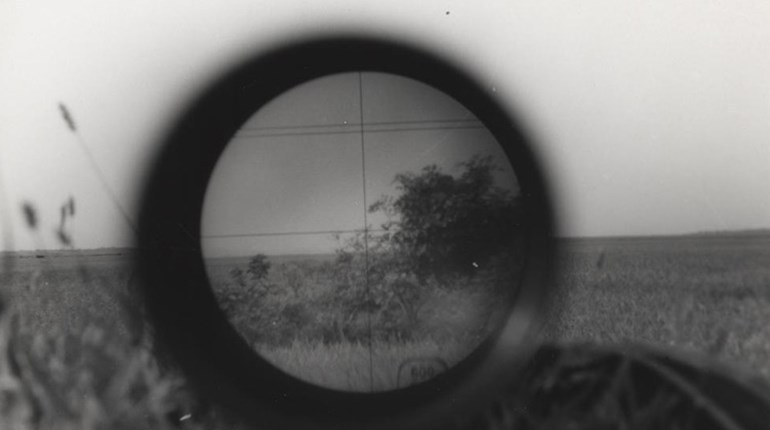For all their revealing brightness, binoculars are dark and mysterious things. Hidden deep within their barrels are chunks of glass and gears the average hunter barely comprehends. How do they manage to make a dim scene at dusk appear brighter? How can they silently focus without any parts moving? How can a 10X binocular be no larger than an 8X? And, most puzzling of all, why does one unit cost $2,000 and another $200 when the view through the former doesn’t look anything close to 10 times better?
We could write a book about all of this, but you wouldn’t need to read it to understand most of what you need to know to save a bundle on an effective hunting binocular. Just as a $400 rifle can “bring home the bacon” as often as a $4,000 rifle, so can lower priced binoculars perform well enough to help you find that “bacon.”
If you’re on a tight budget, the trick to getting an effective binocular is recognizing adequate performance and knowing what ingredients deliver it. Then be prepared to settle for basic functions, treat the instrument with reasonable care and work within its limitations.
For years I’ve been telling folks they could buy a decent binocular for around $200. It would probably be a Porro-prism unit and might not be waterproof, but optical quality would be surprisingly good. But things have been changing in the optical world, and it’s been years since I’ve checked out $200 binoculars. Let’s examine a few and see if my assessment stands.
I regularly peer through and hunt with the finest binoculars on earth, brands like Swarovski, Zeiss and Leica. I’m also privileged to use a lot of top-end units from Meopta, Steiner, Nikon, Vortex, Minox, Bushnell, Alpen, Brunton, Pentax and others. It seems there are more binocular makers than rifle makers these days, and most know how to make good, better and best. A few companies make only top-of-the-line optics, but most will build to “price points” to accommodate those who can’t afford the high-dollar units. What we need to figure out is how low we can go and still get useful function. It’s a waste of time and money to drop $49.99 on a binocular that can’t transmit an image you can identify.
You want to avoid exchanges like this: “Doofus, is it a rock or a deer layin’ out there?”
“I don’t know, Roofus. Can’t quite tell.”
“Well use them binoculars you bought.”
“Oh yeah. Hmm. It’s bigger now, for sure.”
“Yeah, but what is it?”
“Hmmmm. It’s either a really big deer or a rock. But it could be a sheep or maybe an old feed sack.”
If your binocular isn’t any better than that, why carry it? Here’s what a binocular is supposed to do:
1. Magnify
Obviously. But understand that as magnification increases, so do flaws. All else equal, the view is usually better from a 6X than a 10X. You have to pay more to get equal quality at higher magnifications. You also see less area with higher magnification.
2. Transmit light
Most of us think of this as brightness. No binocular “gathers” or increases light. They merely pass it through, losing some at each lens due to reflection. The bigger the objective lenses, the more light that gets in. The higher the magnification, the less light that gets out. Divide objective diameter in millimeters by power to determine diameter of the exit pupil, the tiny circle of light that is transmitted through the eyepieces. If this matches the dilation of your pupils, you get all the light you can absorb. If it’s smaller, you lose light. Pupils dilate to 7mm at dark. A 50mm objective at 10X would produce a 5mm exit pupil. The same 50mm at 7X gives a brighter 7mm exit pupil.
3. Minimize flare
You know that yellow/orange glare and haze you see when glassing toward a low sun? That’s contrast-robbing flare caused by reflected light bouncing inside, lens to lens. Anti-reflection coatings minimize this.
4. Resolve images
This means “sharp.” Objects should appear crisp and well defined, a result of lenses ground properly and positioned perfectly.
5. Endure
Bright, sharp and powerful binoculars are nice, but not if they break down in a season or two. A binocular should be durable enough to take a few bumps and bruises, a bit of dust and rain.
These are the five things you want. So what ingredients deliver them? Look for the following:
1. Glass lenses properly ground
Some cheap binoculars sport plastic lenses—not good enough. A curved glass surface properly ground and polished enlarges viewed objects without waves, blurring, edge distortion, etc. The more precisely lenses are ground, the better the view. Glass lens quality may be compromised by bubbles, inclusions (tiny stones or crystals), pits and scratches. One assumes that low-priced binoculars wear lenses that did not pass inspection for use in higher priced units, but they can at least be ground properly.
2. Coatings
Anti-reflection coatings make binoculars “bright.” Without them, 8 percent of light that strikes a lens is lost to reflection. With five to seven lenses in a binocular, you could lose half the light. Each layer of anti-reflection coating cuts that loss in half, so the more the better.
These coatings also minimize flare, glare or haze. That improves contrast. High contrast is good. It helps you distinguish antlers from branches.
Here are the common codes for delineating coatings:
• Bright optics: Meaningless PR hype. No coatings.
• Coated: One lens surface must have one layer.
• Fully coated: All lenses must have one layer.
• Multi-coated: One lens must have at least two layers.
• Fully multi-coated: All lenses must have at least two layers.
Alas, you cannot tell how many layers are included in “fully multi-coated.” Top-quality units get a half-dozen or more per surface, so we can assume fully multi-coated, low-priced binoculars have no more than two.
3. Efficient prisms
Prisms are large chunks of angled glass that bounce the light to extend its path, necessary for magnification. There are two main types. A Porro-prism binocular sports dog-legged or off-set barrels. The objective lenses are spread wider than the eyepiece lenses. Roof-prism binoculars have straight barrels, so they aren’t as wide. Porro prisms are a bit more fragile than roofs, but can be made equally bright and sharp for about half the cost. Some roof prisms require a mirror on one surface. Aluminum-backed mirrors are cheaper, silver mirrors are brighter but costlier.
You can’t see prisms without dismantling the binocular, so look for the list of ingredients on the box or company catalog. BaK4 glass (barium crown) is better than BK7 (borosilicate crown) for roof-prism styles. In Porro-prism binoculars, BaK4 isn’t an advantage over BK7.
Unfortunately, BaK4 now comes in at least two “flavors.” It appears the Chinese are playing fast and loose with terminology and selling what they call a BaK4 glass that is of much lower quality than the German Schott BaK4 type. Buyer beware. It’s probable that inexpensive binoculars advertising BaK4 prisms are using the Chinese version.
4. High-quality metals, barrels, gears
These are internal parts we can’t see or judge. Assume that an inexpensive binocular is not going to be made of the toughest, most durable stuff. Treat it with care.
5. Precision tolerances, workmanship
Much of this we can see or at least feel. Check how smoothly the eyecups twist up, the diopter ring turns/locks, the focus wheel moves. How does the armor coating fit?
What you see is what you get, so look closely. Take time to run the binocular through a series of tests.
First adjust the spread of the barrels so they fit the interpupillary distance between your eyes. Then adjust the diopter to match your vision. If the diopter adjustment dial is on the right barrel, close your right eye and focus on something with your left, using the main focus wheel. Then close your left eye and focus the same subject with the diopter wheel on the right eyepiece. Now the center focus wheel will work for both eyes at once.
Twist and turn the eyecups to see how smoothly and reliably they raise and lock. Does the focus wheel turn too easily or too hard? Does it grind or catch? Is the hinge tight enough to hold the interpupillary distance you chose? Remember, all tensions will loosen with use.
As a benchmark, compare your $200 binocular against a much pricier model. I tested against a Swarovksi EL 8.5x42. Test for the following, and try more than one of any specific model. At this price point, you’ll often find one unit considerably better than its brothers.
Flare
Look toward the setting sun. Flare will be obvious.
Contrast
If flare is bad, contrast will be bad. High contrast shows as deep colors, black blacks and really bright highlights. Low contrast mutes colors, making scenes look flat.
Resolution
After sunset, try reading small print at a distance, say 30 yards, with binoculars resting on a surface (sandbag is great) so they don’t move. Low light really brings out quality differences. If you must do this in a store, look for the darkest corner. With your target in view, slide across it, watching to see if lettering gets fuzzy in spots. That’s inconsistency in the lenses. Hold the binocular on target and look at the edges for sharpness. Some inconsistent binoculars are sharper on one edge than another and in one eyepiece vs. the other. Some are even sharper on edges than at center. Run the binocular from nearest to farthest focus and compare views at each end.
Brightness
Compare different binoculars in low light, understanding that small exit pupils will transmit dimmer images.
Quality
How precisely do things look, fit and feel? Shine a flashlight into the objective lenses. Are interior walls flat black and clean? No stripped screw heads or strips of glue hanging out? No dust or scratches on the internal lenses? Green, purple and blue reflections usually indicate multi-coatings. White reflections usually indicate no coatings.
Handling
Do they spread to fit your interpupillary distance? Can you reach the focus wheel comfortably? How’s the balance? If you look through them for several minutes, do your eyes start to tire?
Guarantees Is the unit guaranteed for defects and workmanship only, or no-fault? For one-year, 25 years or the owner’s lifetime? Will the manufacturer repair free or replace? Strong guarantees cover the unit from damage, but also suggest the manufacturer is confident the unit is built well and won’t fail.




































